Solar eclipse of September 1, 2016
| Solar eclipse of September 1, 2016 | |
|---|---|
 Map | |
| Type of eclipse | |
| Nature | Annular |
| Gamma | -0.333 |
| Magnitude | 0.9736 |
| Maximum eclipse | |
| Duration | 186 sec (3 m 6 s) |
| Coordinates | 10°42′S 37°48′E / 10.7°S 37.8°E |
| Max. width of band | 100 km (62 mi) |
| Times (UTC) | |
| Greatest eclipse | 9:08:02 |
| References | |
| Saros | 135 (39 of 71) |
| Catalog # (SE5000) | 9544 |
An annular solar eclipse occurred on September 1, 2016. A solar eclipse occurs when the Moon passes between Earth and the Sun, thereby totally or partly obscuring the image of the Sun for a viewer on Earth. An annular solar eclipse occurs when the Moon's apparent diameter is smaller than the Sun's, blocking most of the Sun's light and causing the Sun to look like an annulus (ring). An annular eclipse appears as a partial eclipse over a region of the Earth thousands of kilometres wide. In this case, annularity can be observed in Gabon, Congo, Democratic Republic of the Congo, Tanzania, Mozambique, Madagascar, and Reunion.
Images

Related eclipses
Solar eclipses from 2015 to 2018
Each member in a semester series of solar eclipses repeats approximately every 177 days and 4 hours (a semester) at alternating nodes of the Moon's orbit.
| Solar eclipse series sets from 2015–18 | ||||||
|---|---|---|---|---|---|---|
| Descending node | Ascending node | |||||
| Saros | Map | Saros | Map | |||
120 Longyearbyen, Svalbard | March 20, 2015 Total |
125 | September 13, 2015 Partial | |||
| 130 Balikpapan, Indonesia | March 9, 2016 Total |
135 | September 1, 2016 Annular | |||
| 140 | February 26, 2017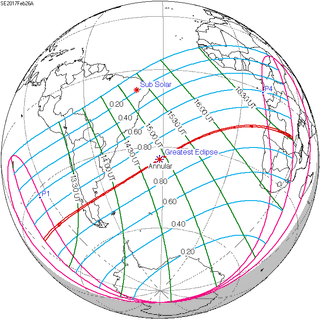 Annular |
145 | August 21, 2017 Total | |||
| 150 | February 15, 2018 Partial |
155 | August 11, 2018 Partial | |||
| Partial solar eclipses on July 13, 2018, and January 6, 2019, occur during the next semester series. | ||||||
Metonic series
The metonic series repeats eclipses every 19 years (6939.69 days), lasting about 5 cycles. Eclipses occur in nearly the same calendar date. In addition the octon subseries repeats 1/5 of that or every 3.8 years (1387.94 days).
| 21 eclipse events between June 21, 1982, and June 21, 2058 | ||||
|---|---|---|---|---|
| June 21 | April 8-9 | January 26 | November 13-14 | September 1-2 |
| 117 | 119 | 121 | 123 | 125 |
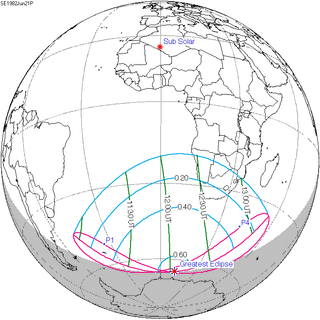 June 21, 1982 |
 April 9, 1986 |
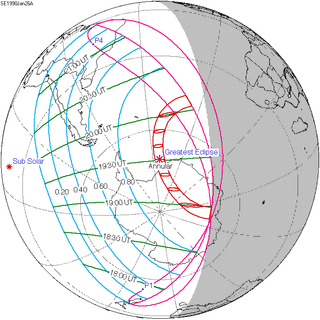 January 26, 1990 |
 November 13, 1993 |
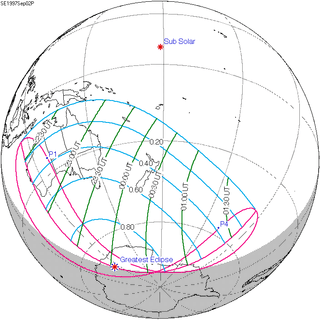 September 2, 1997 |
| 127 | 129 | 131 | 133 | 135 |
 June 21, 2001 |
 April 8, 2005 |
 January 26, 2009 |
 November 13, 2012 |
 September 1, 2016 |
| 137 | 139 | 141 | 143 | 145 |
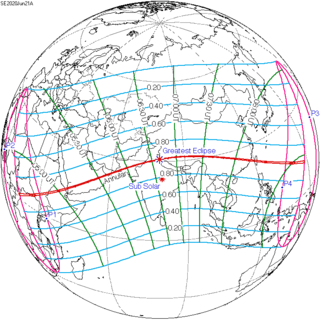 June 21, 2020 |
 April 8, 2024 |
 January 26, 2028 |
 November 14, 2031 |
 September 2, 2035 |
| 147 | 149 | 151 | 153 | 155 |
 June 21, 2039 |
 April 9, 2043 |
 January 26, 2047 |
 November 14, 2050 |
 September 2, 2054 |
| 157 | ||||
 June 21, 2058 | ||||
Notes
References
| Wikimedia Commons has media related to Solar eclipse of 2016 September 1. |
- Earth visibility chart and eclipse statistics Eclipse Predictions by Fred Espenak, NASA/GSFC
- Annular solar eclipse of September 1, 2016
